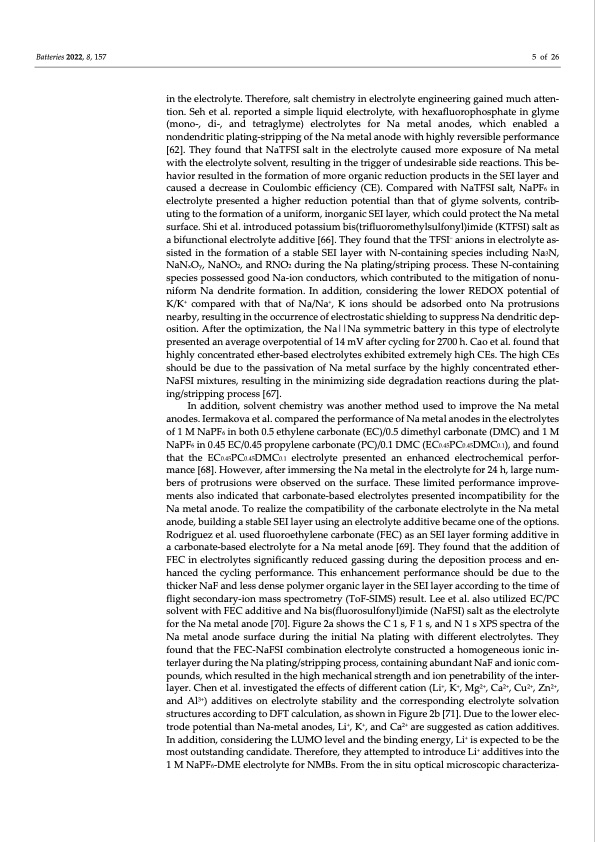
PDF Publication Title:
Text from PDF Page: 005
Batteries 2022, 8, 157 5 of 26 in the electrolyte. Therefore, salt chemistry in electrolyte engineering gained much atten‐ tion. Seh et al. reported a simple liquid electrolyte, with hexafluorophosphate in glyme (mono‐, di‐, and tetraglyme) electrolytes for Na metal anodes, which enabled a nondendritic plating‐stripping of the Na metal anode with highly reversible performance [62]. They found that NaTFSI salt in the electrolyte caused more exposure of Na metal with the electrolyte solvent, resulting in the trigger of undesirable side reactions. This be‐ havior resulted in the formation of more organic reduction products in the SEI layer and caused a decrease in Coulombic efficiency (CE). Compared with NaTFSI salt, NaPF6 in electrolyte presented a higher reduction potential than that of glyme solvents, contrib‐ uting to the formation of a uniform, inorganic SEI layer, which could protect the Na metal surface. Shi et al. introduced potassium bis(trifluoromethylsulfonyl)imide (KTFSI) salt as a bifunctional electrolyte additive [66]. They found that the TFSI− anions in electrolyte as‐ sisted in the formation of a stable SEI layer with N‐containing species including Na3N, NaNxOy, NaNO2, and RNO2 during the Na plating/striping process. These N‐containing species possessed good Na‐ion conductors, which contributed to the mitigation of nonu‐ niform Na dendrite formation. In addition, considering the lower REDOX potential of K/K+ compared with that of Na/Na+, K ions should be adsorbed onto Na protrusions nearby, resulting in the occurrence of electrostatic shielding to suppress Na dendritic dep‐ osition. After the optimization, the Na||Na symmetric battery in this type of electrolyte presented an average overpotential of 14 mV after cycling for 2700 h. Cao et al. found that highly concentrated ether‐based electrolytes exhibited extremely high CEs. The high CEs should be due to the passivation of Na metal surface by the highly concentrated ether‐ NaFSI mixtures, resulting in the minimizing side degradation reactions during the plat‐ ing/stripping process [67]. In addition, solvent chemistry was another method used to improve the Na metal anodes. Iermakova et al. compared the performance of Na metal anodes in the electrolytes of 1 M NaPF6 in both 0.5 ethylene carbonate (EC)/0.5 dimethyl carbonate (DMC) and 1 M NaPF6 in 0.45 EC/0.45 propylene carbonate (PC)/0.1 DMC (EC0.45PC0.45DMC0.1), and found that the EC0.45PC0.45DMC0.1 electrolyte presented an enhanced electrochemical perfor‐ mance [68]. However, after immersing the Na metal in the electrolyte for 24 h, large num‐ bers of protrusions were observed on the surface. These limited performance improve‐ ments also indicated that carbonate‐based electrolytes presented incompatibility for the Na metal anode. To realize the compatibility of the carbonate electrolyte in the Na metal anode, building a stable SEI layer using an electrolyte additive became one of the options. Rodriguez et al. used fluoroethylene carbonate (FEC) as an SEI layer forming additive in a carbonate‐based electrolyte for a Na metal anode [69]. They found that the addition of FEC in electrolytes significantly reduced gassing during the deposition process and en‐ hanced the cycling performance. This enhancement performance should be due to the thicker NaF and less dense polymer organic layer in the SEI layer according to the time of flight secondary‐ion mass spectrometry (ToF‐SIMS) result. Lee et al. also utilized EC/PC solvent with FEC additive and Na bis(fluorosulfonyl)imide (NaFSI) salt as the electrolyte for the Na metal anode [70]. Figure 2a shows the C 1 s, F 1 s, and N 1 s XPS spectra of the Na metal anode surface during the initial Na plating with different electrolytes. They found that the FEC‐NaFSI combination electrolyte constructed a homogeneous ionic in‐ terlayer during the Na plating/stripping process, containing abundant NaF and ionic com‐ pounds, which resulted in the high mechanical strength and ion penetrability of the inter‐ layer. Chen et al. investigated the effects of different cation (Li+, K+, Mg2+, Ca2+, Cu2+, Zn2+, and Al3+) additives on electrolyte stability and the corresponding electrolyte solvation structures according to DFT calculation, as shown in Figure 2b [71]. Due to the lower elec‐ trode potential than Na‐metal anodes, Li+, K+, and Ca2+ are suggested as cation additives. In addition, considering the LUMO level and the binding energy, Li+ is expected to be the most outstanding candidate. Therefore, they attempted to introduce Li+ additives into the 1 M NaPF6‐DME electrolyte for NMBs. From the in situ optical microscopic characteriza‐PDF Image | Electrolyte Engineering for Sodium Metal Batteries

PDF Search Title:
Electrolyte Engineering for Sodium Metal BatteriesOriginal File Name Searched:
batteries-08-00157.pdfDIY PDF Search: Google It | Yahoo | Bing
Product and Development Focus for Salgenx
Redox Flow Battery Technology: With the advent of the new USA tax credits for producing and selling batteries ($35/kW) we are focussing on a simple flow battery using shipping containers as the modular electrolyte storage units with tax credits up to $140,000 per system. Our main focus is on the salt battery. This battery can be used for both thermal and electrical storage applications. We call it the Cogeneration Battery or Cogen Battery. One project is converting salt (brine) based water conditioners to simultaneously produce power. In addition, there are many opportunities to extract Lithium from brine (salt lakes, groundwater, and producer water).Salt water or brine are huge sources for lithium. Most of the worlds lithium is acquired from a brine source. It's even in seawater in a low concentration. Brine is also a byproduct of huge powerplants, which can now use that as an electrolyte and a huge flow battery (which allows storage at the source).We welcome any business and equipment inquiries, as well as licensing our flow battery manufacturing.| CONTACT TEL: 608-238-6001 Email: greg@salgenx.com | RSS | AMP |